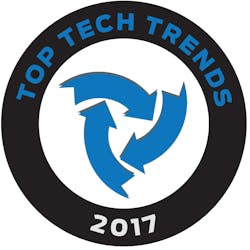Across the healthcare ecosystem, IT leaders at patient care organizations are still grappling with the critical issues of seamlessly exchanging health data across systems and also being able to properly secure it. Indeed, although the healthcare industry is behind most other sectors when it comes to interoperability and security, newfound optimism has emerged in the form of a technology that potentially can help solve both of these challenges—blockchain.
Recent momentum around blockchain in healthcare spurred Healthcare Informatics’ editors to name it as one of our Top Tech Trends for healthcare IT in 2017, despite applications of the technology still being at a nascent level, industry-wide. For a reminder, blockchain technology is most commonly associated with digital currency, and is a data structure that can be time-stamped and signed using a private key to prevent tampering.
Applied to healthcare, blockchain would offer the potential of a shared platform that decentralizes health data without compromising the security of protected health information. Chris Kay, chief innovation officer at the Louisville, Ky.-based Humana, offers a specific example of its prospective use in healthcare: “Imagine that you go to the doctor today and get a blood test, but you need to see a specialist, so a referral is made. But your health records don’t come with you; you show up to the specialist as a new patient. Here, you get a poor customer experience with a lot of friction in that system. But what will it look like in a distributed ledger world where there is cryptography and trust built in such that you as a consumer has a note on the blockchain that contains your health records? The provider who was contracted with an insurance company has the payments and scheduling on separate notes. As that provider makes a note, or does a procedure or a surgery, that becomes an indelible block on the ledger. You are building your health history over time.”
Just as importantly, noted Micah Winkelspecht, founder and CEO of Gem, a Venice, Calif.-based startup developing a blockchain application platform, in an interview with Healthcare Informatics last summer, when the interaction happens, “It becomes your integrity layer, in terms of keeping a time-stamped registry of every document, so no document can be modified without others knowing. And it provides the authenticity layer because every action is authenticated and recorded on the blockchain, so you know who is doing what with the data and at what time.” Winkelspecht, whose company is now focusing more on healthcare and has partnered with the Philips Blockchain Lab, refers to blockchain as the “universal source of truth” and “the interoperability model for how EHRs [electronic health records] should work.”
In a more recent interview, Winkelspecht notes that this shared ledger “is not owned or controlled by any one company, but instead acts like a public utility for the entire industry.” The end result is the patient’s complete medical history, with each transaction linked together by a ledger—but not in a centralized place such as a health information exchange (HIE). In fact, this is what separates blockchain from an HIE, some experts say—there is no one organization holding all of the data in one place, but rather separate entities each holding a “token” on the chain.
“Blockchain effectively takes out the middle man; conceptually you would not have these health information exchanges that have struggled to get to mainstream,” explains Vince Vickers, KPMG’s healthcare technology leader. “There have been a lot of good efforts in certain states, and some HIEs have done well, but in relative terms, [compared] to the financial services industry—where I can go to an ATM, no matter where I am in the world, and get my money—patient data obviously is very limited in that way. And the HIEs are very slow moving. So blockchain is a really interesting disruptor. When you put it in those terms, that it could potentially, not necessarily eliminate HIEs, but at least change them structurally and provide a new value proposition, I see it as potentially picking up a lot of steam,” Vickers says.
Blockchain has recently caught the attention of federal healthcare leaders as well. The Office of the National Coordinator for Health Information Technology (ONC) last year held a “Use of Blockchain in Health IT and Health-Related Research” challenge, which involved soliciting whitepapers on blockchain’s use in healthcare. The agency named 15 winners spanning across the industry, and one key lesson learned from the whitepapers, according to Steve Posnack, director, Office of Standards and Technology at ONC, is that blockchain can complement, enhance and supplement existing infrastructure. “In these types of explorations with its use, there is potential to automate certain things that are routine transactions that otherwise involve human adjudication right now. This [includes] clinical health data exchange or administrative transactions such as financial payments on the claims side,” Posnack says.
To this end, Humana’s Kay says he sees two paths that blockchain can and should take in healthcare: one is figuring out how to flatten that supply chain; and the second is putting the customer in control of his or her health data, and allowing for a seamless exchange of interactions. By far the more inspirational path, he says, is the latter. “If the industry views the potential of blockchain to solve the problems of the industry such as claims cost management and contracting, it won’t reach its potential,” he says. “The real opportunity is to figure out, in the context of the need for us to have better integration and better experiences of better care, how can we enable more seamless care, connect people to the right providers at the right time, and do that in a safe and secure way. That’s where the majority of the value will come from, and it’s the more transformational vision [of blockchain].”
Blockchain Creating Buzz at HIMSS17
At this year’s HIMSS conference in Orlando, blockchain was one of the most highly-discussed conversation pieces in regards to up-and-coming technology in healthcare. In the conference’s opening keynote, Ginni Rometty, president, chairman, and CEO of IBM, said that IBM has many blockchains in production and that “the productivity, authenticity, and transparency you can get through the data is unbelievable,” while predicting that it will “have a profound impact on healthcare.”
Meanwhile, the conference held a day-long blockchain event in which industry experts discussed possible use cases in healthcare and current challenges. The general consensus was that health IT leaders are bullish about the technology’s potential, but equally are hesitant to call it the “magic bullet” for interoperability and security.
During one of the day’s sessions, David McCallie Jr., M.D., senior vice president of medical informatics at the Kansas City-based Cerner Corporation, compared the blockchain hype level to what the industry was saying years ago about the Direct standard for secure email exchange. McCallie noted that the talk about Direct at the time was that nothing could go wrong as the technology part was settled, as was the vendor buy-in part, and the open source implementation, too. But “everything else” other than the IT created problems, including a lack of trust.
Also at HIMSS, Mac McMillan, co-founder and CEO of consulting firm CynergisTek, agreed with Cerner’s McCallie, noting that blockchain “will require real investment and adoption. And people will have to trust it.” McMillan, a notable healthcare data security expert, said that blockchain has the capability and the potential to be transformative in healthcare, and then added, “Here’s something interesting: why did Bitcoin fail? Because people didn’t trust it. It worked great—in fact, it worked so well that all the bad guys got into it. But [because of well-publicized incidents involving fraud and wrongdoing], people lost confidence in the technology, and it failed.”
McMillan, implying that investment in blockchain is not a given, continued, “Here’s an example around investment: all vendors of all kinds [restaurants, grocery stores, department stores, all retail vendors, etc.] are required by law to use electronic credit card readers. But there are still small vendors, like restaurants, that are using those little manual machines that take the physical impression of credit cards. They’re not supposed to do it, but who’s going to crack down on that? So that’s an example of where not everyone has adopted a technology.”
The Road Ahead
In the end, significant challenges remain. For one, it’s still very early on in the process. KPMG’s Vickers says, “If I went out and asked my innovative CIO friends if they know about blockchain in the healthcare industry, eight out of ten wouldn’t know what I’m talking about.” And, beyond the technical side of it, Kay points to the behavioral challenges and the ability of ecosystem partners to get together and start to work together on proof of concepts. “Healthcare is a very siloed industry with stakeholders who have not viewed radical transparency as a way to build their business,” Kay says. “We are early on as an industry, but the speed of change will be driven by learnings from financial services; so we won’t have the same trajectory as they had,” he says. Vickers and Posnack both estimate that blockchain is probably a few years away from becoming “real” in healthcare.
Winkelspecht believes that the hype is not about blockchain itself, but rather “about creating a whole new data paradigm that blockchain enables.” He notes, “While the technology will ultimately unlock trillions of dollars of efficiency currently locked in data silos, we can’t boil the ocean. Vendors must start with simpler projects that deliver clear, immediate and measurable ROI, and then we can scale to the ultimate vision.”
Kay notes that most companies are indeed still in the awareness phase right now, all the way from senior leadership down to software engineering teams, so organizations will continue to build their expertise in this space. CIOs and chief innovation officers will try to figure out how to understand and create a point-of-view about how blockchain will impact existing business models and set more tangible goals that are more action-oriented, Kay says, looking ahead to the next 12 months. “There is a lot of good work happening with blockchain, but we will see more proof of concepts this year in terms of how they are being framed and what problems they are trying to solve—[primarily] that we as consumers will be the master and owner of our own health.”
But Winkelspecht predicts that healthcare will adopt this technology, “first at the fringes in highly specific use cases with new sources of data that don’t currently fit into the existing EHR paradigm, but these use cases will [then] become proving grounds for broad adoption in the industry.” He adds, “I think it will happen faster than finance. I would expect to see the first production healthcare blockchain application go live by the end of the year.”




